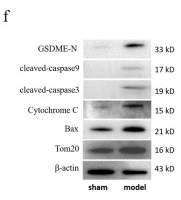DFNA5/GSDME Antibody - N-terminal - #AF4016
Product Info
*The optimal dilutions should be determined by the end user. For optimal experimental results, antibody reuse is not recommended.
*Tips:
WB: For western blot detection of denatured protein samples. IHC: For immunohistochemical detection of paraffin sections (IHC-p) or frozen sections (IHC-f) of tissue samples. IF/ICC: For immunofluorescence detection of cell samples. ELISA(peptide): For ELISA detection of antigenic peptide.
Fold/Unfold
2310037D07Rik; 4932441K13Rik; Deafness, autosomal dominant 5; Deafness, autosomal dominant 5 protein; DFNA5; DFNA5 gene; DFNA5_HUMAN; Dfna5h; EG14210; Fin15; ICERE 1; ICERE-1; Inversely correlated with estrogen receptor expression 1; Non-syndromic hearing impairment protein 5; Nonsyndromic hearing impairment protein; Gasdermin-E;GSDME_HUMAN;ICERE1;
Immunogens
A synthesized peptide derived from human DFNA5(Accession O60443), corresponding to N-terminal amino acid.
Expressed in cochlea. Low level of expression in heart, brain, placenta, lung, liver, skeletal muscle, kidney and pancreas, with highest expression in placenta.
- O60443 GSDME_HUMAN:
- Protein BLAST With
- NCBI/
- ExPASy/
- Uniprot
MFAKATRNFLREVDADGDLIAVSNLNDSDKLQLLSLVTKKKRFWCWQRPKYQFLSLTLGDVLIEDQFPSPVVVESDFVKYEGKFANHVSGTLETALGKVKLNLGGSSRVESQSSFGTLRKQEVDLQQLIRDSAERTINLRNPVLQQVLEGRNEVLCVLTQKITTMQKCVISEHMQVEEKCGGIVGIQTKTVQVSATEDGNVTKDSNVVLEIPAATTIAYGVIELYVKLDGQFEFCLLRGKQGGFENKKRIDSVYLDPLVFREFAFIDMPDAAHGISSQDGPLSVLKQATLLLERNFHPFAELPEPQQTALSDIFQAVLFDDELLMVLEPVCDDLVSGLSPTVAVLGELKPRQQQDLVAFLQLVGCSLQGGCPGPEDAGSKQLFMTAYFLVSALAEMPDSAAALLGTCCKLQIIPTLCHLLRALSDDGVSDLEDPTLTPLKDTERFGIVQRLFASADISLERLKSSVKAVILKDSKVFPLLLCITLNGLCALGREHS
Research Backgrounds
Plays a role in the TP53-regulated cellular response to DNA damage probably by cooperating with TP53.
Switches CASP3-mediated apoptosis induced by TNF or danger signals, such as chemotherapy drugs, to pyroptosis. Produced by the cleavage of GSDME by CASP3, perforates cell membrane and thereby induces pyroptosis. After cleavage, moves to the plasma membrane where it strongly binds to inner leaflet lipids, bisphosphorylated phosphatidylinositols, such as phosphatidylinositol (4,5)-bisphosphate. Mediates secondary necrosis downstream of the mitochondrial apoptotic pathway and CASP3 activation as well as in response to viral agents. Exhibits bactericidal activity.
Cleavage at Asp-270 by CASP3 (mature and uncleaved precursor forms) relieves autoinhibition and is sufficient to initiate pyroptosis.
Cell membrane.
Cytoplasm>Cytosol.
Expressed in cochlea. Low level of expression in heart, brain, placenta, lung, liver, skeletal muscle, kidney and pancreas, with highest expression in placenta.
Intramolecular interactions between N- and C-terminal domains may be important for autoinhibition in the absence of activation signal. The intrinsic pyroptosis-inducing activity is carried by the N-terminal domain, that is released upon cleavage by CASP3.
Belongs to the gasdermin family.
References
Application: WB Species: Mouse Sample: B cells
Restrictive clause
Affinity Biosciences tests all products strictly. Citations are provided as a resource for additional applications that have not been validated by Affinity Biosciences. Please choose the appropriate format for each application and consult Materials and Methods sections for additional details about the use of any product in these publications.
For Research Use Only.
Not for use in diagnostic or therapeutic procedures. Not for resale. Not for distribution without written consent. Affinity Biosciences will not be held responsible for patent infringement or other violations that may occur with the use of our products. Affinity Biosciences, Affinity Biosciences Logo and all other trademarks are the property of Affinity Biosciences LTD.

